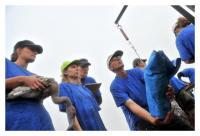After an obligatory briefing the previous evening, the 175 people involved in the 33rd greater flamingo ringing operation were finally ready. The rendezvous was for 5:30 a.m. on 27th July at the entrance to the Fangassier Islet, the only breeding site in France.
 In the half-light, the 9 teams formed up and spread along the dikes according to the pre-established plan. The aim was to encircle the nursery of 500 chicks slowly and silently, and drive them into the enclosures so that each chick could be ringed. This process is called “herding”. Although they were highly dispersed, the vast majority of the chicks were herded into the corral, and the ringing operation could commence.
In the half-light, the 9 teams formed up and spread along the dikes according to the pre-established plan. The aim was to encircle the nursery of 500 chicks slowly and silently, and drive them into the enclosures so that each chick could be ringed. This process is called “herding”. Although they were highly dispersed, the vast majority of the chicks were herded into the corral, and the ringing operation could commence.
 Weigh, measure, ring.Each chick goes through the same process thanks to its “bander”. In addition to the standard steps, samples need to be taken: one for genetic research, another for malaria, a third to compare its blood count with captive flamingos in Basle zoo, and a fourth for parasites.
Weigh, measure, ring.Each chick goes through the same process thanks to its “bander”. In addition to the standard steps, samples need to be taken: one for genetic research, another for malaria, a third to compare its blood count with captive flamingos in Basle zoo, and a fourth for parasites.
Unfortunately, after a few minutes, the rain gate-crashed the party, and forced us to adapt. Both ringers and chicks remained valiant and the operation continued, although the taking of certain samples had to be abandoned.
A good result nonetheless. 423 chicks were ringed, and more than a hundred measured and weighed. The sampling teams did not go home empty-handed, although they would have hoped to obtain a larger number of samples.
Despite the inclement climatic conditions, the scientific operation was carried out without harming the chicks.
A television crew for the programme “Des racines et des ailes” (Roots and Wings) was also present throughout the ringing process, in the framework of a documentary on the Camargue.
Les photos de l’évènement sont téléchargeables ici.
© crédits photos : H. Hôte / Agence Caméléon